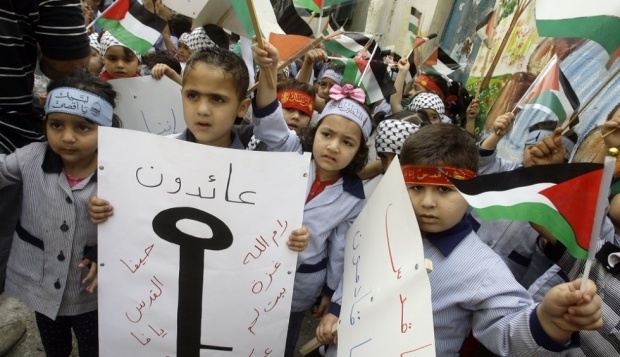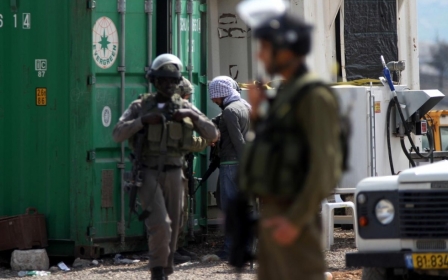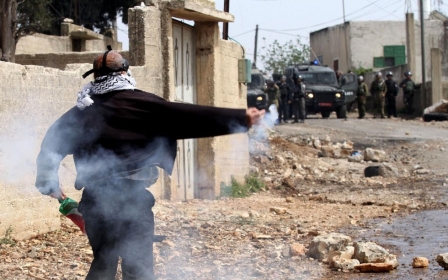Commemorating Land Day

The late Mahmoud Darwish famously lamented: “I come from there … and remember.” On 30 March, 1976, I woke up to the rumbling of tank tracks on the unpaved rocky road in my home village in Israel’s Northern District. This was a first. Even in the lead-up to the Nakba, the 1948 displacement of Palestinians by Israelis, Arrabeh had been spared the sight of tanks in its streets.
My little nephews and nieces in the shared household scampered to the bathroom with fright-induced diarrhea. But I wanted to laugh: to prevent us from going on strike for one day in protest against a new wave of land confiscation, prime minister Yitzhak Rabin and defense minister Shimon Peres, later to share the Nobel Peace Prize with Yasser Arafat, ordered their top crack troops into our villages to enforce a curfew they imposed on Palestinian communities in Israel.
Not only did that compel us all to abide by our strike decision; it also led to the few government lackeys who were bent on breaking it being attacked and severely beaten by undiscriminating soldiers.
A neighbour was shouting at the top of his voice for me to come and help his wife, who had gone into labour. I stepped out the door carrying my doctor’s bag and waved my stethoscope towards the tank. A soldier aimed his gun in my direction, and I ran back in and closed the door.
There and then I wrote my letter of resignation from my Ministry of Health position as a district physician. Continuing to hold such a job, I concluded, would taint me in the eyes of my aggrieved community.
Soon the police brought an unresponsive old neighbour for me to check. When the patient was alone with me, he opened his eyes and told me he was all right. “Just send me to the hospital,” he whispered. I did, and the police also agreed to transport the neighbour who was in labour. She delivered a healthy girl her parents named “Thaira”, Arabic for “rebel”.
The old man, Hassan Naamni, became a living legend of peasant resistance: he had been arrested and beaten while bringing home two buckets full of earth from his land, which had been designated for appropriation by the government. He explained that after the confiscation he would have nowhere to be buried, and hence he needed the earth from his land.
His wife, Nada, was less poetic; she went after the soldiers with a stick. A tank was cornered in a narrow alley under a hail of stones from the likes of Nada, forcing its commander to negotiate with the mayor for a safe exit, or so Arrabeh’s heroic legend chroniclers would have you believe.
Other incidents didn’t end so peacefully: Israel’s security forces killed six youths, including Kheir Yassin, a fellow villager I knew well.
Land is at the base of all that troubles our relationship as Palestinians within Israel and with Israel as our state. The Nakba of 1948 left us a leaderless and disorganised rural minority on the wrong side of a vicious border. Nearly one-third of us were internally displaced, thus forfeiting our rights to our land and property under a specially formulated Israeli law. Those are the “Present Absentees”, a living contradiction attesting to the land as the base of the conflict.
We have come a long way since, though not as far as our Jewish co-citizens. “Their” majority group defined “our” minority out of the state’s conception of its common good and security concerns.
Laws, rules and regulations continue to be promulgated to disadvantage us, especially on land-related matters. Some three-dozen Israeli laws enable the shifting of land ownership from us to the state, while only the Jewish majority can access state lands.
We now make up near one fifth of Israel’s population but own only a 3 percent - and constantly shrinking - stake in its land and have possible access to another 4 percent. All the remainder is held in perpetuity for the Jewish people, de facto if not always de jure.
The state’s insatiable coveting of our land on one side and our subsistence farming roots on the other made the clash of “Land Day” in 1976 unavoidable. It was less than a decade since Israel had extended its military rule over us across the “Green Line” to the Palestinian Occupied Territories, where it still applies today. Under draconian emergency regulations, it appropriated our communal lands and much of our privately owned lands.
So when in 1976 Israel beckoned to us to yield yet another large swath of our agricultural land, we stood as one man and said “No!” It was a first for us, conceptually the first Palestinian Intifada. It deserved to be commemorated wherever Palestinians aspired to assert their identity and their right to their land.
With the accelerating post-Oslo ascent of messianic settlers to positions of power in Israel, both in government and in the command ranks of the security forces, the encroachment on what remains of our land has accelerated further, especially in the Negev.
Repeatedly, specialised governmental planning committees have fetishized the collective eviction of entire Bedouin villages from ancestral lands. The rationale is to make room for Jewish National Fund afforestation projects and for new Jewish settlements. Again and again, security forces arrive under the cover of darkness to demolish Bedouin homes. The Supreme Court of the land has sanctioned such actions.
The recent elections in Israel have unified our formerly factional Arab political parties under a charismatic young leader, Ayman Odeh. His first major public action is to lead a six-day march on Jerusalem on the occasion of Land Day to protest against the ongoing exiling of Negev Bedouins, the weakest link in our communal unity.
Elsewhere we continue to lose our land, at pain of penalty of law, to infrastructure development projects, new parks and public spaces while our villages are severely constrained in their residential zones.
The same process is underway in the West Bank, conducted through the crosshair sites of the army’s and the settlers’ automatic weapons, witness the ongoing cleansing of Palestinian farmers and shepherds in the Jordan Valley and the Hebron Hills.
An analysis by Amira Hass, as quoted in Mondoweiss, is spot-on: “When you look at the geography of Palestinians in Israel, it’s the same geography, they are encircled in enclaves. They are deprived of their land. Most of their land has been taken by Jews to settle, even though they [the Palestinians] are Israeli citizens… They are all packed and cramped in houses without spaces to breathe, without agricultural lands… The political geography of the Israeli state is very similar on both sides of the Green Line.”
Hass concludes with a question she was once asked by a Palestinian attacked by settlers: “Tell me Amira, don’t Israelis think about their grandchildren?”
It is time the international community, especially the United States and the European Union, took notice of their moral responsibility towards the Palestinians on both sides of the Green Line as the victims of its proxy colonialist project.
Boycott, Divestment and Sanctions, the nonviolent resistance movement launched by the Palestinian civil society in 2005 as a proven tactic to counter apartheid, deserves the support of the masses the world over, but especially in the West.
- Hatim Kanaaneh is a public health physician and a Palestinian citizen of Israel who has lived and practiced his profession in his home village in Galilee for over four decades. He is the author of the short story collection Chief Complaint: A Country Doctor’s Tales of Life in Galilee (Just World Books, 2015) and of a book of memoirs, A Doctor in Galilee: The Life and Struggle of a Palestinian in Israel (Pluto Press, 2008.)
The views expressed in this article belong to the author and do not necessarily reflect the editorial policy of Middle East Eye.
Photo: Palestinian children hold up pictures of keys, symbolising the homes they left behind (AFP)
Middle East Eye propose une couverture et une analyse indépendantes et incomparables du Moyen-Orient, de l’Afrique du Nord et d’autres régions du monde. Pour en savoir plus sur la reprise de ce contenu et les frais qui s’appliquent, veuillez remplir ce formulaire [en anglais]. Pour en savoir plus sur MEE, cliquez ici [en anglais].





